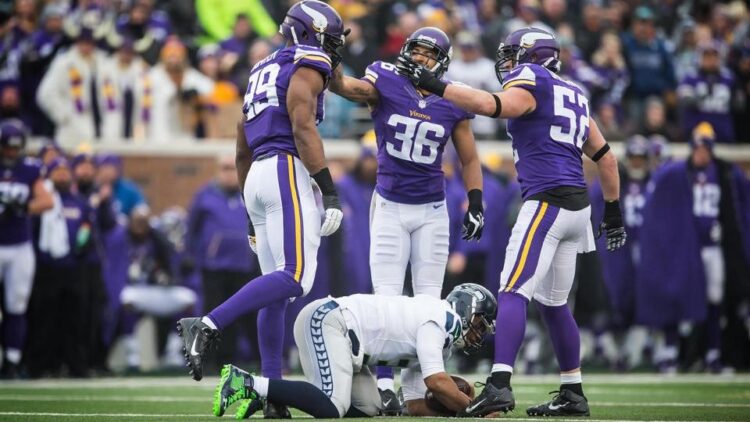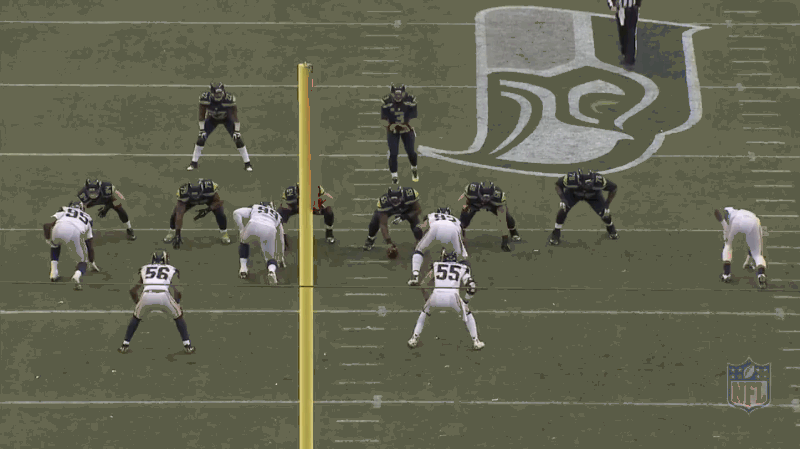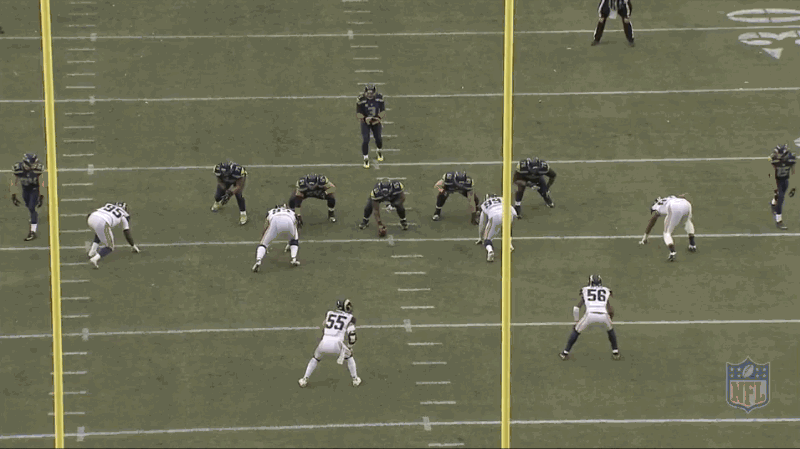To Beat Seattle, the Vikings Must Pressure Wilson

Sifting through recent Seattle Seahawks game film, it’s difficult to find many weaknesses for the Minnesota Vikings to exploit. Russell Wilson is playing at MVP levels, especially as of late. In Seattle’s last seven games, he’s thrown 24 touchdown passes and just one interception, helping him finish the season as the first player in NFL history to record at least 4,000 passing yards, 30 passing touchdowns, and 500 rushing yards in a single season. Known more for his mobility than his ability from within the pocket, Wilson is thriving as a traditional pocket passer. This season, he’s posted a 118.6 passer rating when throwing from the pocket, which is higher than any qualifying quarterback in the past three years.
When the Vikings and Seahawks met last, Wilson hurt Mike Zimmer’s defense every which way. He scored one touchdown on the ground and threw another three, two of which were 20 or more yards down the field. That game kickstarted his stretch of All-Pro play and helped the Seahawks win six of their last seven games. But that game was also a lopsided affair, one that found the Vikings shorthanded on the defensive side of the ball. Missing three of their most important players — one at each level of the defense — the Vikings surrendered 433 yards to the Seahawks and allowed a season-high 38 points. Finally healthy and playing some of their best football, the Vikings have the chance to upset the Seahawks and win their first playoff game.
But how can they slow down Wilson and Seattle’s suddenly dangerous passing attack? It’s simple — put pressure on the quarterback and blitz.
According to Robert Mays at MMQB, Zimmer blitzes at a below-average rate, often choosing to send just four rushers at the quarterback. Despite their statistical lack of aggressiveness, the Vikings finished the season with the fourth-highest pressure rate in the league and generated pressure on 49.4 percent of their blitzes. That wasn’t the case in Week 13, when the Vikings sacked Wilson once and missed countless other opportunities to bring him down.
In five of Seattle’s six losses this year, Wilson’s been sacked four or more times. And in their recent five-game win streak (Weeks 11-15), Wilson was only sacked six times. The very next game, though, Wilson was harassed by the St. Louis Rams, who swept the season series behind two impressive defensive outings. Their most recent in Week 16 laid the groundwork for beating the Seahawks, which begins by attacking Seattle’s below-average offensive line.
As Mays points out, Seattle’s line was 31st in pressure rate from Weeks 1 through 8 before “improving” to 26th from Weeks 9 through 17. Pro Football Focus shares similar criticism for the unit, handing them the fifth-worst pass blocking efficiency grade in the league. According to the analytics site, three of Seattle’s offensive linemen finished the season with “replaceable” grades, and their best lineman (LT Russell Okung) is fighting through nagging injuries.
Against the Rams, they allowed four sacks and another 13 quarterback pressures, forcing Wilson to revert to his “backyard football” ways. Often, it’s Wilson’s escapability that makes him so dangerous, but against the Rams’ deep group of edge rushers and defensive tackles, it hindered the offense. The spins that he’s made so famous turned five-yard losses into 10 or 15-yard sacks, putting Seattle in even worse field position situations.
How’d the Rams do it? Simply put, they confused the Seahawks and outmuscled them on the edges, taking advantage of one-on-one matchups with pass-blocking tight ends and running backs. A litany of blitzes created free rushers for the Rams, who didn’t allow Wilson to sit in the pocket and hit Doug Baldwin down the field. If the Vikings want to move past the Wild Card round, they’ll need to replicate the pressure the Rams created. To do that, Zimmer has to blitz Russell Wilson and hope his edge rushers keep “outside contain” if the mobile quarterback breaks the pocket.
Sacks, Sans-Blitzes
As mentioned above, the Rams were able to pressure Wilson without sending more than four rushers. At times, they sent just three, dropping defensive tackles like Aaron Donald into coverage to confuse Wilson’s pre-snap reads. Creating that hesitation forces Wilson’s eyes “down,” disrupting the rhythm of the offense and swinging favor back into the defensive line’s hands. On the next three plays, St. Louis dominates Seattle up front, most notably when presented favorable matchups, i.e. tight ends and running backs in pass protection.
On the left side of the screen, William Hayes lines up shaded to the left of the tight end. Even before the ball is snapped, Seattle is at a disadvantage. Imagine the Vikings in this situation; could Kyle Rudolph or MyCole Pruitt be trusted to block a defensive end one-on-one? The answer, 10 times out of 10, is no. And that’s the case for Seahawks tight end Cooper Helfert, who is “put on skates” against Hayes. The defensive end drives Helfert into Wilson’s lap with a bull rush, then attacks the inside half of the blocker’s body to shed and force the sack.
For the Vikings, Brian Robison and Danielle Hunter should have no problem taking advantage of such situations. The last meeting, Seattle spread the Vikings out, but the weather wasn’t below-freezing. If the Seahawks are forced to tun the ball, they’ll have to use more tight end-heavy sets and formations, which may lead to more one-on-one matchups for Minnesota’ defensive ends.
Again, the Rams rush just four, and again Hayes wins his battle on the edge. However, St. Louis confuses Wilson by dropping a defensive tackle into coverage. The protection inside is stout, but Wilson’s pump fake and dropped eyes don’t allow him to step up and escape the pocket. Hayes shows off more pass rushing prowess, attacking the right tackle’s outside shoulder before executing a push-pull move to shed the block. He catches Wilson in a patented spin and brings the quarterback down for another loss.
For a second time, imagine Brian Robison in a similar situation. Lined up one-on-one with the inexperienced Gary Gilliam, he should be able to force Wilson out of the pocket. His chances are only aided by a healthy Linval Joseph, who makes his return to the field on Sunday and will only add to the Vikings’ pass rushing ability on the defensive line.
Hayes makes Gilliam look silly with a speed rush around the edge, notching one of his three sacks for the game. Notice Robert Quinn feigning a rush on the left side of the screen, only to drop as a “spy” on Wilson. For a second time, Wilson attempts to spin, but ends up right in the hands of a defender.
Blitz the Birds
In the series of screen grabs below, the Rams send two exotic blitzes to attack Wilson. Unlike the Vikings, they don’t take advantage of A-gap blitzes. Rather, they delay their linebackers and send pressure through the B and C-gaps. It’s a method the Vikings can replicate with their cornerbacks, safeties, and linebacker Anthony Barr. Captain Munnerlyn and Harrison Smith are two of Zimmer’s options to send off the edge. He can also employ the strategy he used sparingly against the New York Giants, showing A-gap pressure, only to drop Everson Griffen in coverage to confuse Eli Manning. Griffen nearly came away with an interception and has the ability to play in space. Remember his pick-six against the Rams in 2012?
It’s no given that the Vikings can create the same pressure against the Seahawks, but defensively, it’s their best chance to beat Seattle. On a frigid morning at TCF Bank Stadium, Wilson may feel more than the cold air; he could be in for a world of hurt against Minnesota’s aggressive front-seven.




You must be logged in to post a comment.